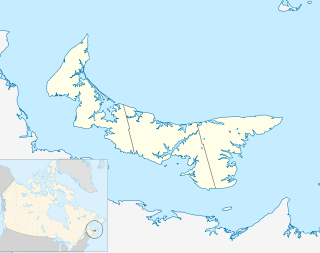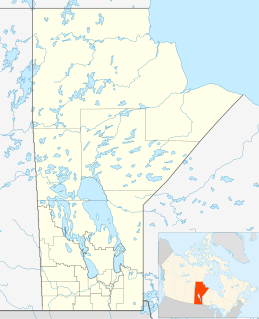
The British Commonwealth Air Training Plan (BCATP), or Empire Air Training Scheme (EATS) often referred to as simply "The Plan", was a massive, joint military aircrew training program created by the United Kingdom, Canada, Australia and New Zealand, during the Second World War. BCATP remains as one of the single largest aviation training programs in history and was responsible for training nearly half the pilots, navigators, bomb aimers, air gunners, wireless operators and flight engineers who served with the Royal Air Force (RAF), Royal Navy Fleet Air Arm (FAA), Royal Australian Air Force (RAAF), Royal Canadian Air Force (RCAF) and Royal New Zealand Air Force (RNZAF) during the war.

Mont-Joli Airport is located 1.5 nautical miles north northwest of Mont-Joli, Quebec, Canada. It is the only airport with scheduled service in the Bas-Saint-Laurent region.
Canadian Forces Base Clinton, CFB Clinton for short, was a Canadian Forces Base located near Clinton, Ontario. It initially opened in July 1941 as RAF Station Clinton under the British Commonwealth Air Training Plan as a training unit for radar operators during a period when radar was a top secret device. UK, Canadian, US and other servicemen were trained at Clinton, with practical flights being carried out at nearby RCAF Station Centralia. Clinton remained the primary radar training site for Canadian Forces personnel through the Cold War era, with continued expansions throughout the 1950s and 60s. As part of a centralization effort, CFB Clinton was closed in 1971, with the site abandoned by 1972. A number of buildings remain on the site, including a large "golf ball" radome.

RCAF Station Mount Pleasant was a Royal Canadian Air Force (RCAF) station in Mount Pleasant, Prince Edward Island, Canada. Two of its runways remain in use by members of the Experimental Aircraft Association.

RCAF Station Charlottetown was a Royal Canadian Air Force station located in Sherwood, Prince Edward Island. Today's Charlottetown Airport maintains a remnant of the airfield's runways near its general aviation terminal, however all buildings and most infrastructure have been removed.

Canadian Forces Detachment Mountain View, also CFD Mountain View, is a Canadian Forces airfield located in Prince Edward County, Ontario, south of Belleville. It is geographically close to CFB Trenton, which has administrative responsibility for the facilities.

RCAF Station Dafoe was a Second World War Royal Canadian Air Force station located near Dafoe, Saskatchewan, Canada. The station was home to the British Commonwealth Air Training Plan's No. 5 Bombing and Gunnery School. The school opened January 1941 and closed January 1945. Aircraft used include the Westland Lysander, Bristol Bolingbroke, Avro Anson, and Fairey Battle.

Canadian Forces Base Picton was a military installation located in Picton, Ontario. The base was active from the Second World War to 1969 and served the Royal Air Force, Royal Canadian Air Force and Canadian Army. Today, the site functions as the Picton Airport.

RCAF Station Macdonald was a RCAF air training station located 16 km (10 mi) northwest of Portage la Prairie, Manitoba.

CFB Rivers was a Royal Canadian Air Force base located 5 km (3.1 mi) southwest of Rivers, Manitoba, Canada at the junction of Manitoba Highway 25 and Manitoba Provincial Road 259.
Eastern Air Command was the part of the Royal Canadian Air Force's Home War Establishment responsible for air operations on the Atlantic coast of Canada during the Second World War. It played a critical role in anti-submarine operations in Canadian and Newfoundland waters during the Battle of the Atlantic. Eastern Air Command also had several fighter squadrons and operational training units under its umbrella.

Royal Canadian Air Force Station Jarvis was a Second World War British Commonwealth Air Training Plan (BCATP) station located near Jarvis, Ontario. The station was home to No. 1 Bombing and Gunnery School and is usually known by that name. Bombing and Gunnery schools trained Air Gunners, Wireless Air Gunners, Air Observers, Air Bombers, and Navigator-Bomb Aimers. These airmen served as aircrew on bombers and maritime patrol aircraft.
No. 1 General Reconnaissance School RCAF was a flight training unit in 3 Training Command, of the Royal Canadian Air Force, flying Avro Ansons from RCAF Station Summerside, PEI.
No. 2 Air Navigation School was a navigation training school in No. 3 Training Command RCAF, of the British Commonwealth Air Training Plan("BCATP"), flying Avro Anson's from RCAF Station Pennfield Ridge. It was opened on 21 July 1941 and closed on 30 April 1942. A second school with the same number opened at RCAF Station Charlottetown on 21 February 1944 and closed on 7 July 1945.
No. 32 Air Navigation School RAF was a flight training squadron in 3 Training Command, of the Royal Canadian Air Force flying Avro Anson's from RCAF Station Charlottetown, PEI.
No. 8 Service Flying Training School RCAF was a flight training squadron in 3 Training Command, of the British Commonwealth Air Training Plan (BCATP), flying Avro Ansons from RCAF Station Moncton, New Brunswick. The school was opened 23 December 1940. The school was relocated to RCAF Station Weyburn, Saskatchewan on 24 January 1944 and was disbanded 30 June 1944.
No. 13 Service Flying Training School RCAF was a RAF flight training unit flying Avro Ansons from RCAF Station St Hubert, Quebec and later from RCAF Station North Battleford, Saskatchewan. It was part of No. 3 Training Command RCAF carrying out British Commonwealth Air Training Plan ("BCATP") operations.

RCAF Station Paulson was a Second World War, British Commonwealth Air Training Plan facility located near Dauphin, Manitoba, Canada.
No. 3 Training Command RCAF was a training command of the Royal Canadian Air Force during World War II established to administer the schools of the British Commonwealth Air Training Plan.







